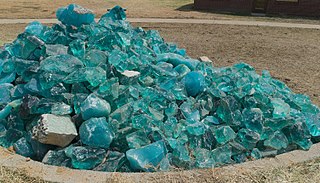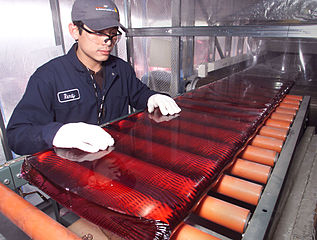Glass Colours
by Ibraheem RodriguesGlass chemistry is a complex subject, and as such the following descriptions are merely a guide based on descriptions and photos. Colours can vary wildly depending on conditions of manufacture, contamination and even heating/cooling of the glass.
It is also worth noting that there are a few mechanisms by which these metals give glass colour. Some ions are simple doping of the glass, as is the case with many modern glass colors, while some are colloidal particles, such as red gold glass. Some colours are brought about by simple absorption, while others are from light scattering, producing colours unrelated to the metal’s absorption spectra.
Many more great photos can be seen in the smart-elements.com catalogue.
| Metal | Glass Color 1 2 3 | Image |
|---|---|---|
| Boron + Sulphur | Blue tint, seen in many common glass objects. | |
| Carbon Oxides | Amber-brown | |
| Sodium Nitrate | A decolourising agent. | |
| Titanium | Yellow-brown | |
| Vanadium | Green | |
| Chromium | Dark green. | |
| Manganese Compounds | Purple/violet. A decolourising agent in low concentrations. Some varieties can fluoresce red under UV light. |
|
| Iron | Bluish-greens and browns |  |
| Cobalt | Deep blue/purple. |  4 4 |
| Nickel | Blue to Violet to Black. Used to decolourise lead glass. |
|
| Copper | Dark opaque red, blue, greens | |
| Niobium | Deep to light blue | |
| Selenium | Reddish. Decolourises in low concentrations. |
|
| Molybdenum | Brown/ Purple through blue/cyan, depending on oxidation state | |
| Rhodium | Red-brown | |
| Silver (Nitrate, Halides) | Red-orange to yellow. Heavily affected by heating and cooling of glass. |
|
| Cadmium-Sulphur Compounds | Yellow to orange to brown-red |  5 5 |
| Antimony | White, red-yellow | |
| Tin Compounds | Milky white. | |
| Tungsten | Deep blue | |
| Iridium | Amber | |
| Gold | Red (‘Ruby Gold’, often from lead glass), red-pinkish (‘cranberry’) in low concentrations) |  6 6 |
| Bismuth | Orange | |
| Cerium | Colourless. Fluoresces blue under UV light | |
| Praseodymium | Yellow | |
| Samarium | Blueish-green. Fluoresces orange under UV light | |
| Europium | Pink/orange tint. Fluoresces red under UV light | |
| Terbium | Colourless. Fluoresces yellow under UV light | |
| Thulium | Yellow-green | |
| Dysprosium | Colourless. Fluoresces green under UV light | |
| Thulium | Yellow-green | |
| Uranium (‘Vaseline’ glass) | Yellow-green. Glows under UV light |  7 7 |
| Neodymium | Reds/purples. Used in high power lasers. |
 |
| Praseodymium | Greens | |
| Didymium (Praseodymium & Neodymium mixture) | Green, or lilac-red. Used in safety glasses and optical filters, blocking yellowish light |
 8 8 |
-
https://en.wikipedia.org/wiki/Glass_coloring_and_color_marking (Accessed 14/05/2020) ↩
-
https://geology.com/articles/color-in-glass.shtml (Accessed 14/05/2020) ↩
-
https://www.smart-elements.com/wp/category/glassbeads/ (Accessed 14/05/2020) ↩